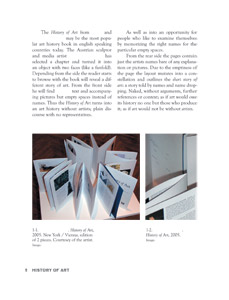Imagining the Book II, International Biennial Alexandria, Apr 15 - Jun 1, 2006 |
 |
 |
 |
 |
 |
||||||||||
|
Artist Book "History of Art"
|
Art Work for Catalogue front side
|
... rear side
|
Bibliotheca Alexandria
|
|||||||||||
|
Accompanying Symposium
|
||||||||||||||
The "History of Art" from Janson is the most popular art history book in english speaking countries. Richard Jochum has selected a chapter and turned it into an object with two faces (fanfold). Depending from the side the reader starts to browse with the book will reveal a different story of art. From the front side he will find Jansons text and accompanying pictures but empty spaces instead of names. Thus the "History of Art" turns into an art history without artists; plain discourse with no representatives. (And into an opportunity for people who like to examine themselves by memorizing the right names for the particular empty spaces.)
From the rear side the pages contain just the artists names bare of any explanation or pictures. Due to the emptiness of the page the layout becomes a constellation and outlines the short story of art: a story told by names and name dropping. Naked, without arguments, further references or context; as if art would owe its history no one but those who produce it; as if "art" would not be without artists.
The contribution for the catalogue repeats the idea and self-applies it to the project. It replaces the imagery of the "History of Art" book with 2 sample pictures from the art object. The text describes the project and while the front side includes images and text without names, the rear side contains only the names.
The exhibition in Alexandria is accompanied by a symposium about concepts and future of artist books held at the Bibliotheca Alexandria.
Images #4+5: Katja Zboralski